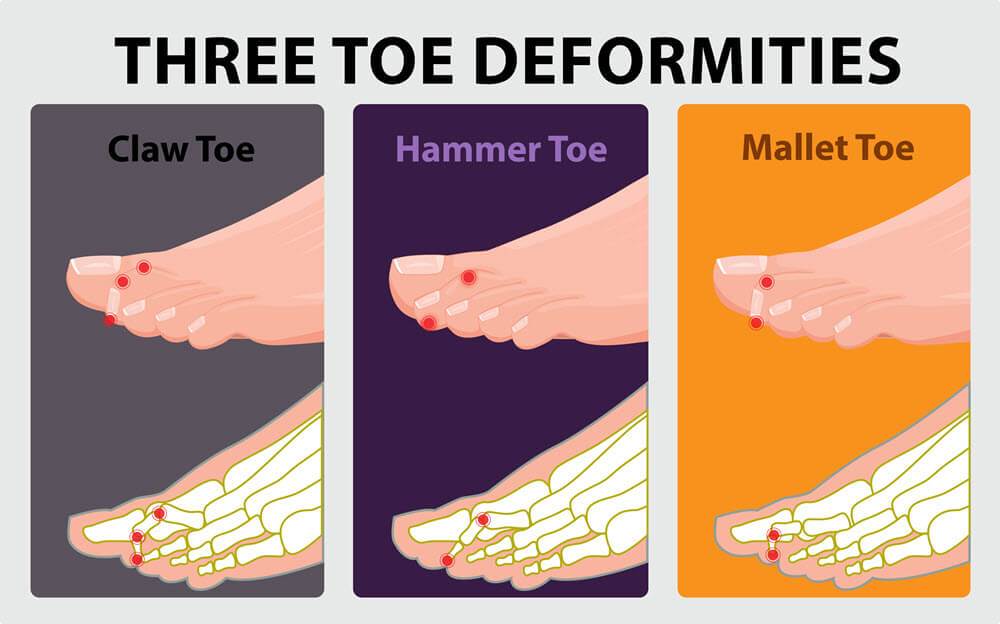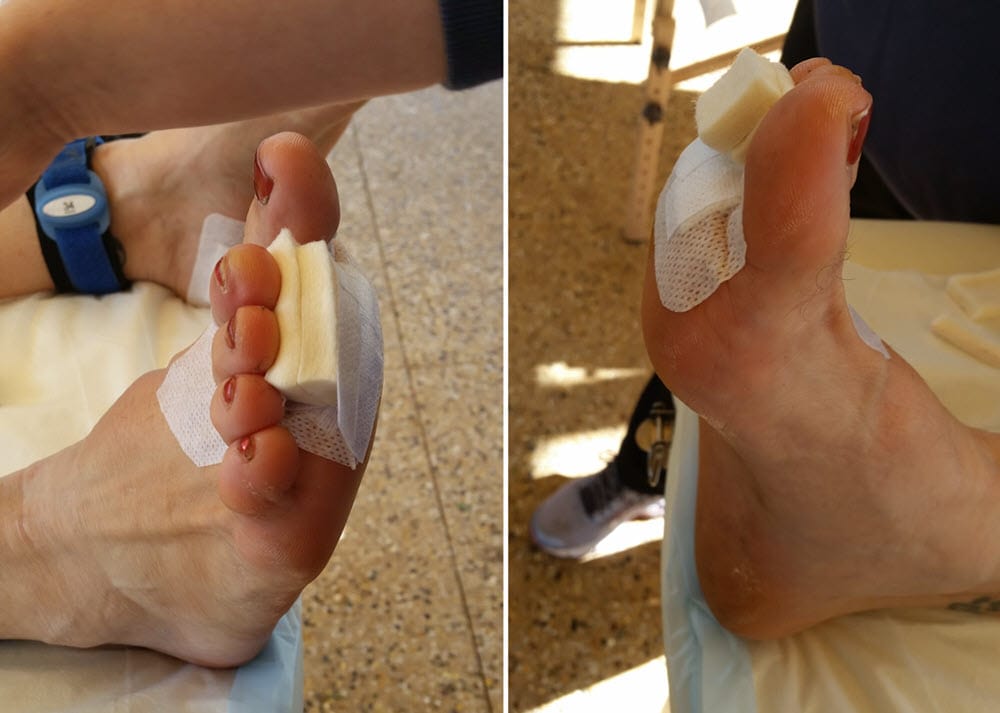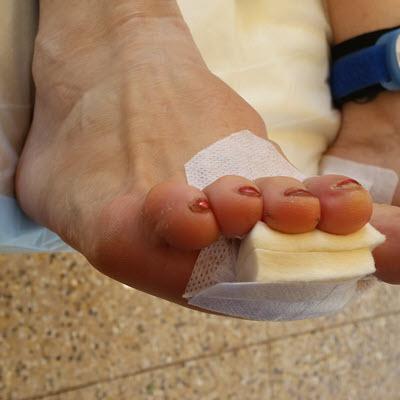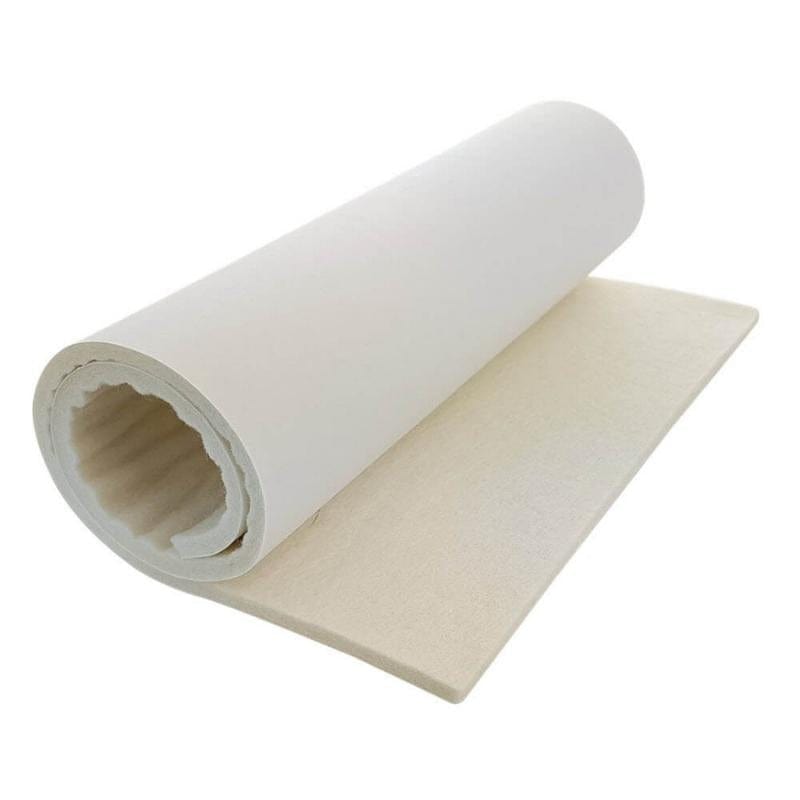But when toenail blisters are due to the posture of your toe, impeccable toenail care won’t be enough. If your toes bend over, the tip of the toe becomes weightbearing, which it isn’t designed to be. This pressure to the tip of the toe, and hence the free edge of the nail, forces the toenail back towards the toe with each step, ever so slightly. Stride after stride, hour after hour, the skin of the nail bed shear (stretches) repetitively. This insult adds up with a blister under the nail the result. Or a black toenail.

These toe postures lead to pressure at the tip of the toe, which translates to pushing the nail back, with blister-causing skin shear at the nail bed the result.
Toe-prop case study
This was the case for a 72 hour ultramarathon runner in Adelaide in October 2019. She presented concerning an early stage blister under the second toe nail at the 23 hour mark saying:
It’s on its way – I always get it. Is there anything you can do?
Once we established the cause was the toe posture (not shoes too small or too loose or anything else), the answer was simple. We needed a toe-prop.
DIY toe-props

This is the felt toe-prop we made for the 2nd and 3rd toes. You’ll notice we’ve dressed a blister further down under the ball of the foot – that is external to the prop. Did you know that a clawed or hammered toe posture makes the joint under the ball of the foot stick out more, making it more likely to blister. By holding the toe straighter, it’s conceivable that this blister is less likely to happen too.
Get yourself some adhesive orthopaedic felt (aka podiatry felt). Felt is great for making your own donut pads and pressure-deflection pads for blisters. It’s a must-have in your blister kit!
Cut two pieces of felt so they’ll fit under the toes, from the base of the toe to just short of the tip of the toe (just past the last joint). You can make it as long as you need. We applied this to toe number 2 (which had a blister already) and toe number 3 (which was blister-free at this stage but has a history or blistering much later than the second toe).
Stick one piece in place, then the other on top. You can have more (or less) layers if you need to.
Then you fasten it all down and into place with a fixation tape like Fixomull Stretch.
How do toe-props work?
These pieces of felt form a little pillow and takes up the space required for the toes to bend, making them sit straighter. There’s simply no room for the tip of the toe to move back towards the foot as it bends.
Other types of toe-props
There are more permanent forms of toe-props, but we didn’t have access to them at the race. Felt is absolutely serviceable in this situation. I often use this exact technique in my podiatry clinic to offload the tip of the toe in the short term – for 3-5 days of standard daily activities. The Fixomull is water-resistant, so it will keep the prop in place in spite of it getting wet. And is more than up to the job in a running or trekking scenario.
The felt prop was doing fine 7 hours later - we talked about it during a pit stop relating to another matter. We had to replace it after about 26 hours as we needed to redress a blister under the ball of the foot, and the toeprop had been applied over the top part of the dressing.
Did it help this runner?
Amazingly so!
I mean, I wasn’t amazed at all. But it was a revelation to her. The blister didn’t get any worse, in fact, it didn’t hurt after we applied it. And the 3rd toe blister never eventuated.
Why? Because we isolated the cause of the toenail blister and we took it out of the equation. This is how to deal with blisters. It starts with finding the cause of the blister and then nullifying it.
This runner hadn’t seen her podiatrist in a couple of years. But after this, she was planning a visit to get her orthotics checked and get a more permanent prop that she can use right from the start of her next race.
Moral of the story
As I indicated in last week’s post, there’s more than one reason for toenail blisters. If your toes curl over (hammertoe / claw toe / mallet toe), either custom-made or DIY toe-props are likely to be the best prevention for this blister. Get yourself some felt and Fixomull, just in case you need to make one in the future. Or see your podiatrist for a longer-lasting one.








